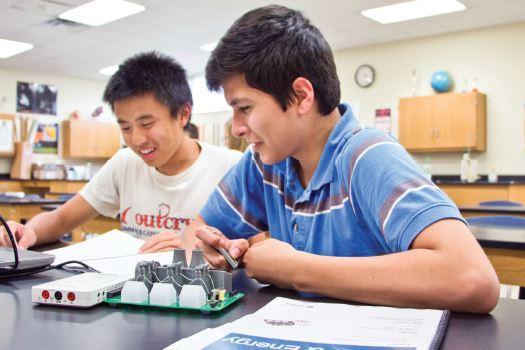Advanced Career Teachers Share Invaluable Insights From the Classroom
“I believe the Aerospace Engineering curriculum is helping students to learn and to think like engineers,” says Bill Vivian, who teaches the Advanced Career Aerospace Engineering curriculum at Sun Valley High School in Charlotte, North Carolina.
Kimberly Cortines, an AC Aerospace Engineering teacher at Oak Hill High School in Oak Hill, West Virginia, says, “The AC curriculum works well with all types of students … everyone is engaged, and everyone is getting technical skills and concepts that will help them in the future.” From Cortines’ perspective, schools typically don’t focus enough on building students’ 21st-century skills. Contrarily, through AC, her students have “learned to work collaboratively in teams … and have learned many skills that, even if they don’t go to college, will help them to make a career of choice.”
Similar thoughts resonated with all the AC teachers I had the opportunity to interview for this article. Their insights can be beneficial to new AC teachers, school leaders interested in adopting AC programs, prospective students, parents, community and industry partners.
AC Students See Purpose and Own Their Learning: Teachers Facilitate
Common themes emerge among students and teachers in an AC classroom. Students begin to challenge themselves — even those who typically would not put in the effort — and see the relationships between their academic studies and what’s required in the workforce through the authentic team projects they produce in class. “Students see a future that they didn’t know existed,” adds Vivian.
Teachers see themselves as facilitators. Travis James, who teaches AC Innovations in Science and Technology at Pocahontas High School in Pocahontas, Arkansas, says the ownership of learning in his class shifted from him to his students. “The ownership is real and they [students] push each other. They know they need to bring their work up to another level, understand their responsibilities and don’t want to let each other down.”
Sara Smith, AC Clean Energy Technology teacher agrees. “In this class, I am more of a facilitator,” she says. Smith teaches the AC courses at Goose Creek High School in Goose Creek, South Carolina. She guides the students to see where they need to go and what they need to do. She says, “The curriculum pushes students to do more than they have done.”
Toby Craver, the AC Integrated Production Technologies teacher at Fountain Lake Charter High School in Hot Springs, Arkansas, says before starting the IPT course, he did not believe high school students could manage the challenging assignments that AC requires. “I thought the assignments were too robust; students would get lost in the mix and never get to what they were trying to create. In retrospect, I underestimated what these high school students could do when given meaningful assignments,” he admits. Today, his students are thriving. AC has helped them to “become more interested in school,” he proclaims, and this shift is resonating with all teachers.
James says his AC Innovations in Science and Technology class teaches students that there is no one way of doing something. “Students think of how to solve problems on their own and then come together as a team. They enjoy collaboratively examining the strengths and weaknesses of their approaches and arguments.” Further, “AC gives them an application or a vision of how and where math and literacy are used in real-world situations and why they need it.”


